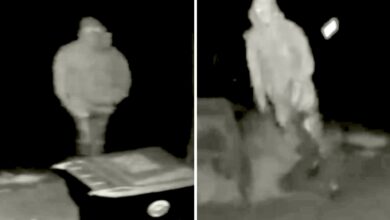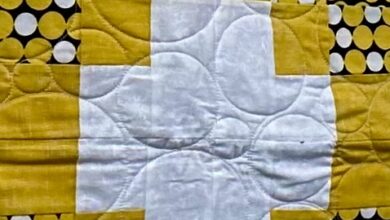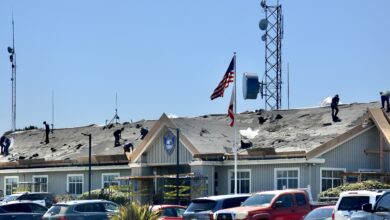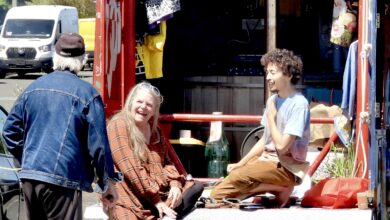Local crabbers wait after Bay Area oil spill
The recent oil spill that fouled Point Reyes could easily have also soiled the Mendocino Coast, said Richard Charter, co-chair of the Outer Continental Shelf Coalition.
More than 58,000 gallons of bunker oil spilled into the San Francisco Bay Nov. 7 after the South Korean tanker Cosco Busan collided with the Bay Bridge.
“During the much larger tankship Puerto Rican spill in 1984, oil was still moving around in the surf as far north as Little River, from an accident that took place right off of the Golden Gate, so we know the Mendocino Coast is in jeopardy whenever we have a spill off San Francisco,” Charter said.
He said good luck with the vagaries of weather, ocean current patterns, the properties of the spilled oil, and the relatively small volume of oil spilled kept the oil away this time.
For now, the biggest local impact may be on crab fishermen.
About a dozen Fort Bragg commercial crab fishing boats are waiting to see when they can start dropping their pots after the oil spill spoiled plans for a Nov. 15 opening in San Francisco.
Also in Noyo Harbor, the Coast Guard will be doing spot safety checks this year designed to protect workers in what has been termed the most dangerous job in the nation.
Tommy Ancona, owner of Tommy”s Marine in Noyo Harbor, said 10 to 12 local boats normally would have gone out to start crab fishing off Central California until boat owners voted not to start commercial fishing, due to concerns about bringing crab up through the spilled oil.
Locals will now wait for the opener for Fort Bragg to the Oregon border, which is scheduled for Dec. 1. There is no indication that the spill will have any direct impact north of Point Reyes, according to trajectory maps released by San Francisco State University.
Commercial boat owners met in San Francisco last week and voted to request that the governor close the just-opened recreational crabbing season in San Francisco and delay the commercial opener.
With the Monday holiday, the decision was set to be made when state officials were back in their offices sometime after Tuesday.
“The impact here is that some crab boats are sitting here and waiting to see how long the season will be delayed,” said Ancona, who holds a crab license but is too busy to fish this year.
Recreational fishing off Fort Bragg is due to open Nov. 24, but could also be delayed.
Pat Heavyside, who operates a small commercial crab boat out of Noyo Harbor, said the closure won”t impact him because he only fishes locally and wasn”t planning to go out until after the Dec. 1 opening.
“Some of the larger boats do go down to crab in the San Francisco area,” Heavyside said. “From what I”ve heard they”re just staying home and waiting for our opener.”
A big brand new crab boat in Noyo Harbor, the Fierce Leader, goes to Alaska in pursuit of the king crab.
California”s crab season had been set to open on Nov. 15 for the Central Coast (Avila-Morro Bay to the mouth of the Russian River). Because the oil spill contaminated waters above some of the best crab grounds, the fishermen did not want to bring their pots up through the stinking mess and possibly contaminate healthy crabs.
Ancona understands the reasoning behind taking crabs off the market and the commercial fishers voluntarily shutting down their season.
“It”s all about consumer perception. But that can be a two-edged sword,” said Ancona.
Maps released by SFSU show the spill hitting Point Reyes and Angel Island, but not spreading to a large area where it might contaminate crab fishing grounds.
“Over this weekend when we had significant amounts of oil on our coastal waters as far north as Point Reyes, and the Point Reyes National Seashore was seriously oiled, it appeared that the various offshore components of this spill seemed to stall and get kicked offshore by natural forces,” said Charter.
Charter said Mendocino Coast people shouldn”t depend on luck with oil spills.
“Any time an oil spill happens in or outside of San Francisco Bay, the Mendocino Coast is potentially in the path of the slicks. In this context, it obviously seems reasonable to find out whether oil spill response agencies could deploy oil skimmers and booms in the midst of offshore arrays of wave energy devices. It does not seem plausible to insulate the environmentally-sensitive Mendocino County coastline from oil cleanup techniques we may well need to quickly deploy here during the next spill.”
Coast Guard crab fishing program returns
Whenever crab season does open, the Coast Guard has announced they will resume a special program of conducting safety spot-checks and encouraging voluntary dockside exams in Humboldt, Del Norte and Mendocino county ports prior to the local crab opening.
“The most dangerous job in America continues to be commercial crab fishing,” the Coast Guard press release read. “Every year, California fishermen lose their life during crab season, and West Coast crabbing vessels continue to have the highest fatality rate of any West Coast fishery.”
The effort is part of the Coast Guard”s “Operation Safe Crab,” an initiative launched in 2004 to reduce the loss of lives and fishing vessels in the West Coast crab fleet.
Coast Guard personnel will again spot-check crab vessels for the required primary lifesaving equipment, pot-loading practices affecting stability and vessel watertight integrity.
“These safety checks have greatly reduced the number of potential casualties,” the release states. “For example, previous years” statistics show that nearly one-third of EPIRBs (Emergency Position Indicating Radio Beacons) and life-rafts are installed incorrectly. This type of situation is easily corrected on the spot, and has helped prevent needless tragedies at sea for California”s crab fleet. Crab vessels with serious safety discrepancies, such as overloading, lack of watertight integrity, missing primary life saving equipment or non-functioning EPIRBs can be restricted from operating until the discrepancies are corrected.”
California crab fishers can also contact their local commercial fishing vessel safety dockside examiner with any questions. Implemented in 1991, the Coast Guard”s Commercial Fishing Vessel Safety Program is designed to help commercial fishermen identify and eliminate potential safety hazards. Free vessel safety assessments, EPIRB testing, training on stability, safety drills and damage control, as well as required placards and literature are available. Successful completion of a dockside exam can also make any future Coast Guard boarding at sea greatly abbreviated, the press release stated.




